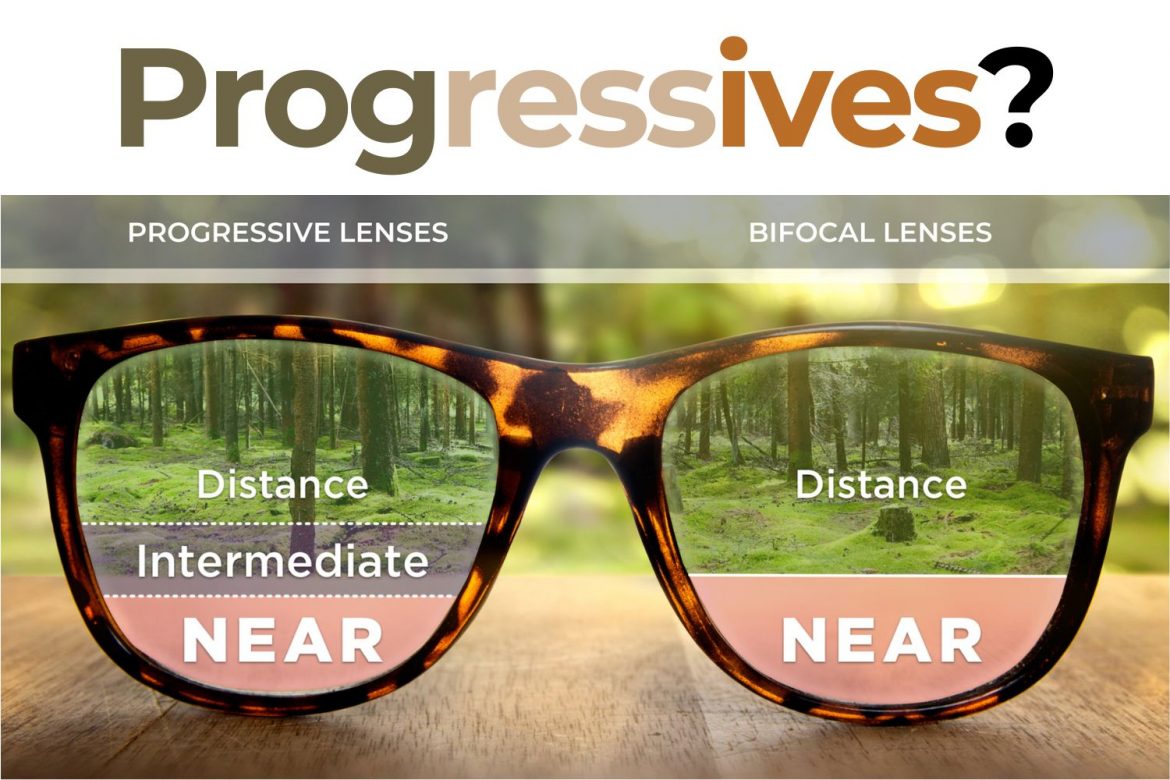1168 total views , 9 views today
Progressive lenses, also known as multifocal lenses or PALs (progressive addition lenses), are a lenses designed to provide clear vision at multiple distances without the need for separate pairs of glasses. PALs are primarily used to treat presbyopia, an age-related condition that affects the eye’s ability to focus on up-close objects.
Progressive lenses provide a smooth and seamless transition between different prescription strengths within a single lens. Unlike traditional bifocal or trifocal lenses, progressive lenses do not have visible lines separating the different prescription strength zones. Instead, the lenses gradually change in power from the top (distance vision) to the bottom (near vision), with intermediate powers located in between.
The lens is divided into three parts:
- Distance vision: the upper portion
- Intermediate vision: the middle portion
- Near vision: the lower portion
Who benefits from a progressive lens?
Those with presbyopica benefit most from a progressive lens. Progressive lenses offer a seamless solution for clear vision at varying distances, eliminating the need to switch between multiple pairs of glasses for different tasks offering added convenience. Progressive lenses are particularly beneficial for certain sports, hobbies, occupations, and daily vision demands.
Those who participate in a variety of activities throughout the day, such as professionals working on computers, or anyone with a dynamic lifestyle, will also benefit from their convenience. Clear vision can be achieved for distance, intermediate, and near tasks without the need to constantly change glasses.
Because there are no visible segment lines on progressive lenses, they look more attractive than traditional bifocal or trifocal lenses. They are preferred by those who want a more natural, younger, and attractive appearance in their eyewear.
What are the advantages of progressive lenses?
Progressive lenses offer several advantages over a traditional single-vision or bifocal lens. Progressive lenses provide a smooth and gradual transition between different prescription strengths for distance, intermediate, and near vision. Unlike bifocals or trifocals, there are no visible lines on the lenses, which can cause an image drop or depth perception difficulties.
The wearer can perform various activities without switching between different pairs of glasses. Progressive lenses mimic the natural way the eyes adjust to different distances. This makes the transition between near, intermediate, and distance vision more natural and comfortable.
Lastly, buyers may save some money buy investing in one pair of glasses with three solutions vision solutions.
Are their disadvantages to progressive lenses?
While progressive lenses offer many advantages, there can be an adaptation period for wearers who are new to this type of lens. Progressive lens wearers may experience peripheral distortion or a “swimming” effect, especially in the early stages of adaptation. This distortion is present in the peripheral zones of the lens and may cause discomfort for some wearers. The wearer must learn to move their nose towards what they are viewing instead of just their eyes.
The size and shape of the eyeglass frame can also impact the effectiveness of progressive lenses. Some frames may not provide enough space for the progressive zones and limit the usable portion of the lens. If your frames are too small, do not fit correctly or the measurements are incorrect, you may have trouble moving your eyes through the varying distances. With time and proper fitting, most people can adapt to progressive lenses.
Though progressive lenses are versatile, they may not be the best choice for certain activities that require extensive use of a specific vision zone. For example, some individuals will still prefer occupational or computer glasses for use with multiple desktop monitors or single-vision reading glasses for long periods of reading.
Lastly, progressive lenses are usually more expensive than single-vision or traditional bifocal lenses.
What should you understand about progressive lens technology?
Today’s progressive lenses are referred to as digital freeform lenses, while earlier generations were called conventional lenses. While both are multifocal lenses designed for clear vision at all distances, there are differences in the underlying technology.
Conventional lenses have a standard, mass-produced design that is not customized for the needs of the wearer. The design is based on average parameters. In comparison, freeform digital lenses are customized and optimized based on the specific prescription and parameters of the individual wearer. The lens design considers the frame shape, tilt, and how the glasses sit on the wearer’s face.
Conventional progressive lenses have the surface ground and polished using traditional methods, while freeform lenses are digitally optimized using advanced computer algorithms for a more precise and customized lens surface.
The digital customization of the lens for its wearer results in a quicker adaptation period because of a reduction in peripheral distortions and improvements in visual clarity. The wearer will experience more natural and comfortable vision when compared to a conventional lens.
What else should you know before investing in progressive lenses?
Before getting progressive lenses, you should have a comprehensive eye exam to determine the correct prescription and identify any other vision issues or eye health concerns. You can expect your prescription to change over the years and will therefore need to purchase new lenses.
Good news: progressive lenses are available with many options including anti-reflective coatings, Transitions lenses, and tints or polarization for sunglasses.
Proper fitting is crucial for the successful use of progressive lenses. An optometrist or an optician will take precise measurements to ensure that the lenses align correctly and distance zones are appropriately positioned.
Even if you have struggled with a progressive lens in the past, it may be time to try again. The technology continues to improve year after year. With more customizations, even those who were unsuccessful in the past, may find it easier to adapt to today’s progressive lenses.


